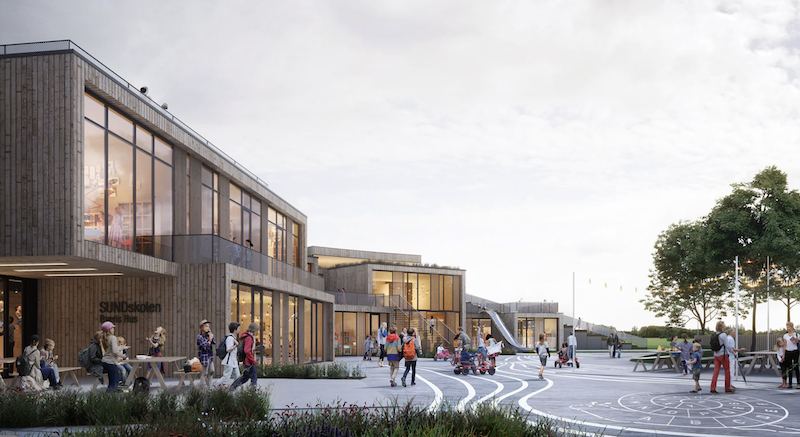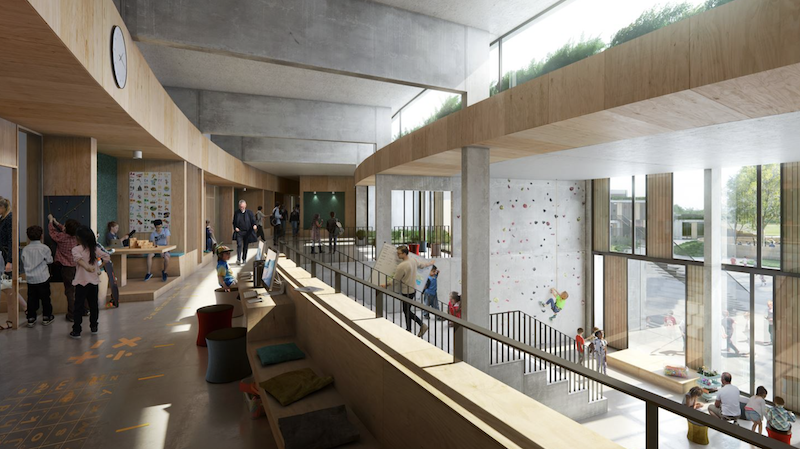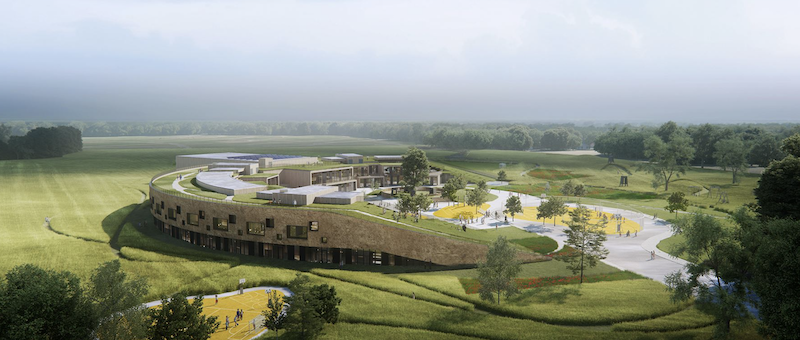The New School in Sundby, set to become Denmark’s first Ecolabel primary school, has broken ground in the Lolland-Falster region. The project has ambitious goals for both sustainability parameters as well as local learning and community engagement.
With an aesthetic that would be at home in The Shire, the design of the school blends with the land with its sloped roof touching down to the ground level. The design takes advantage of the school’s proximity to nature and hill bring the outdoors, and an active, outdoor attitude, inside. The school will have a variety of flexible spaces, both inside and out, that will become a tool for new ways of learning and working.

The New School in Sundby will be the first Nordic Swan Ecolabel Primary School in Denmark. The Nordic Ecolabel is the region’s official sustainability certification based on a range of parameters for energy consumption, indoor climate, chemical exposure, and sustainable material use.
The school will officially open its doors to approximately 580 students up to grade nine and 100 staff at the end of summer 2022. Henning Larsen is partners on the project with SKALA Architects, ETN Architects, MOE, and Autens on a team led by BO-HUS.

Related Stories
| Jun 20, 2014
HOK releases proposal for Obama Library and Museum Campus
Proposal would locate the library in Chicago's historic Bronzeville neighborhood, aiming for urban revitalization as well as Living Building certification.
| Jun 20, 2014
First look: Hive-like 'Learning Hub' to be built in Singapore
In a competition to design a "Learning Hub" for students at Nanyang University in Singapore, London-based firm Heatherwick studio has won with a rounded, hive-like design.
| Jun 18, 2014
Study shows walkable urbanism has positive economic impact
Walkable communities have a higher GDP, greater wealth, and higher percentages of college grads, according to a new study by George Washington University.
| Jun 18, 2014
Arup uses 3D printing to fabricate one-of-a-kind structural steel components
The firm's research shows that 3D printing has the potential to reduce costs, cut waste, and slash the carbon footprint of the construction sector.
| Jun 16, 2014
6 U.S. cities at the forefront of innovation districts
A new Brookings Institution study records the emergence of “competitive places that are also cool spaces.”
| Jun 12, 2014
Zaha Hadid's 'gravity defying' Issam Fares Institute opens in Beirut
The design builds upon the institute’s mission as a catalyst and connector between AUB, researchers and the global community.
| Jun 12, 2014
Tod Williams Billie Tsien Architects' design selected for new UCSC facility
The planned site is a natural landscape among redwood trees with views over Monterey Bay, a site that the architects have called “one of the most beautiful they have ever worked on.”
| Jun 12, 2014
Austrian university develops 'inflatable' concrete dome method
Constructing a concrete dome is a costly process, but this may change soon. A team from the Vienna University of Technology has developed a method that allows concrete domes to form with the use of air and steel cables instead of expensive, timber supporting structures.
| Jun 11, 2014
David Adjaye’s housing project in Sugar Hill nears completion
A new development in New York's historic Sugar Hill district nears completion, designed to be an icon for the neighborhood's rich history.
| Jun 9, 2014
6 design strategies for integrating living and learning on campus
Higher education is rapidly evolving. As we use planning and design to help our clients navigate major shifts in culture, technology, and funding, it is essential to focus on strategies that help foster an education that is relevant after graduation. One way to promote relevance is to strengthen the bond between academic disciplines and the campus residential life experience.
















